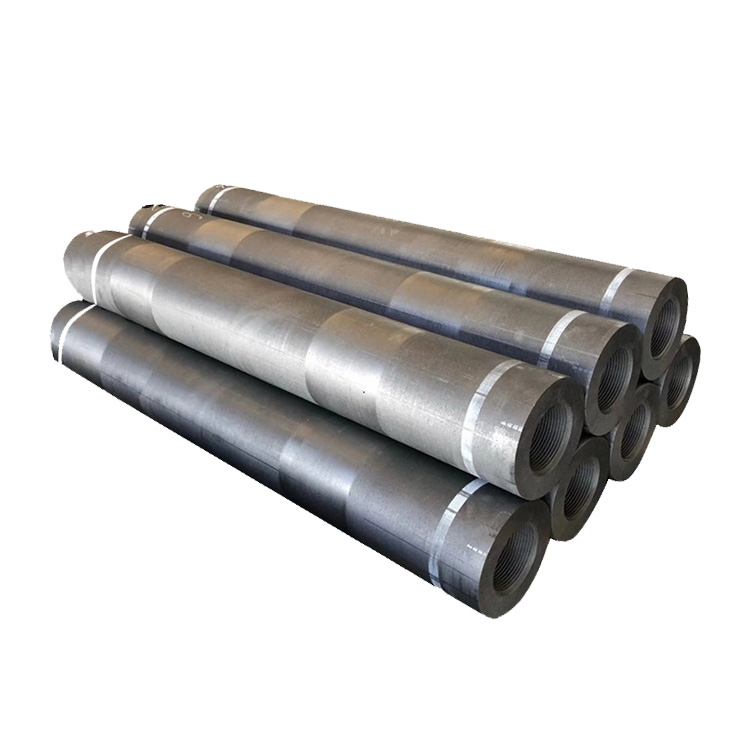Features
- High current carrying capacity.
- Outstanding resistance to breakage.
- High resistance to oxidation and thermal shock.
- Good dimension stability, not easy to deform.
- High mechanical strength, low electrical resistance.
- High machining accuracy, good surface finishing.
Application
Graphite electrodes are widely used for production of alloy steels, metal and other nonmetallic materials, etc.
Technical Specification of RP Graphite Electrode
| Dia. |
Resistance |
Density |
Flexure Strength |
Elastic Modulus |
Ash Content |
CTE |
Current Load |
Current Density |
| (inch) |
(≤, µΩ·m) |
(≥, g/cm3) |
(≥, MPa) |
(≤, GPa) |
(≤, %) |
(100 °C – 60 °C) |
(A) |
(A/cm2) |
|
|
|
|
|
|
(≤, 10-6/°C) |
|
|
| 8 |
8.0 |
1.58 |
10.0 |
9.3 |
0.5 |
2.9 |
5000–6900 |
15–21 |
| 9 |
8.0 |
1.58 |
8.5 |
9.3 |
0.5 |
2.9 |
6100–8600 |
15–21 |
| 10 |
8.0 |
1.58 |
8.5 |
9.3 |
0.5 |
2.9 |
7000–10000 |
14–20 |
| 12 |
8.0 |
1.58 |
8.5 |
9.3 |
0.5 |
2.9 |
10000–13000 |
14–18 |
| 14 |
8.0 |
1.57 |
7.5 |
9.3 |
0.5 |
2.9 |
13500–18000 |
14–18 |
| 16 |
8.0 |
1.57 |
7.5 |
9.3 |
0.5 |
2.9 |
18000–23500 |
14–18 |
| 18 |
8.0 |
1.57 |
7.5 |
9.3 |
0.5 |
2.9 |
22000–27000 |
13–17 |
| 20 |
8.0 |
1.57 |
7.5 |
9.3 |
0.5 |
2.9 |
25000–32000 |
13–16 |
| 22 |
8.0 |
1.57 |
7.5 |
9.3 |
0.5 |
2.9 |
32000–40000 |
13–16 |
| 24 |
8.0 |
1.57 |
7.5 |
9.3 |
0.5 |
2.9 |
38000–47000 |
13–16 |
Graphite Electrode Size & Tolerance
| Diameter (mm) |
Length (mm) |
| Nominal Diameter |
Actual Diameter |
Nominal Length |
Tolerance |
Short Length |
| (inch) |
(mm) |
(max.) |
(min.) |
(rough spot) |
| 8 |
200 |
205 |
200 |
197 |
1600 |
±100 |
-275 |
| 9 |
225 |
230 |
225 |
222 |
1600 |
| 10 |
250 |
256 |
251 |
248 |
1600/1800 |
| 12 |
300 |
307 |
302 |
299 |
1600/1800 |
| 14 |
350 |
357 |
352 |
349 |
1600/1800 |
| 16 |
400 |
409 |
403 |
400 |
1600/1800/2000/2200 |
| 18 |
450 |
460 |
454 |
451 |
1600/1800/2000/2200 |
| 20 |
500 |
511 |
505 |
502 |
1800/2000/2200/2400 |
| 22 |
550 |
562 |
556 |
553 |
1800/2000/2200/2400 |
| 24 |
600 |
613 |
607 |
604 |
2000/2200/2400 |
Surface Quality
There should be less than two defects or holes on the electrode surface, the maximum size of which is mentioned in the below chart.
There should be no transverse crack on the electrode surface. For the longitudinal crack, the length should be less than 5% of the electrode circumference and the width should be 0.3 mm to 1.0 mm.
The width of black area on electrode surface should be less than 1/10 of the electrode circumference and the length should be less than 1/3 of the electrode.
| SpecificationDefect Dimension |
Nominal Diameter of Graphite Electrode (mm) |
| 300–400 |
450–600 |
| Diameter (mm) |
20–40 |
30–50 |
| (< 20 mm should be negligible) |
(< 30 mm should be negligible) |
| Depth (mm) |
5–10 |
10–15 |
| (< 5 mm should be negligible) |
(< 10 mm should be negligible) |










